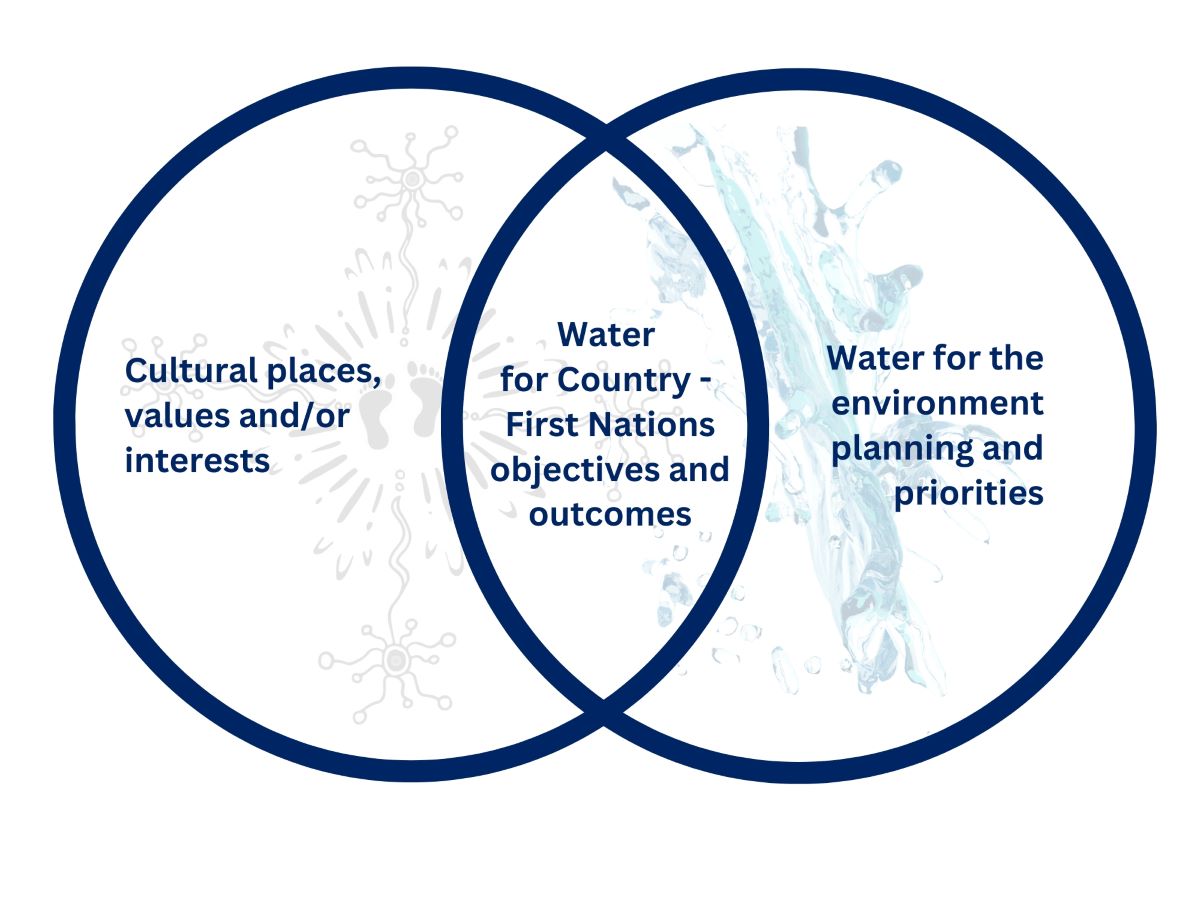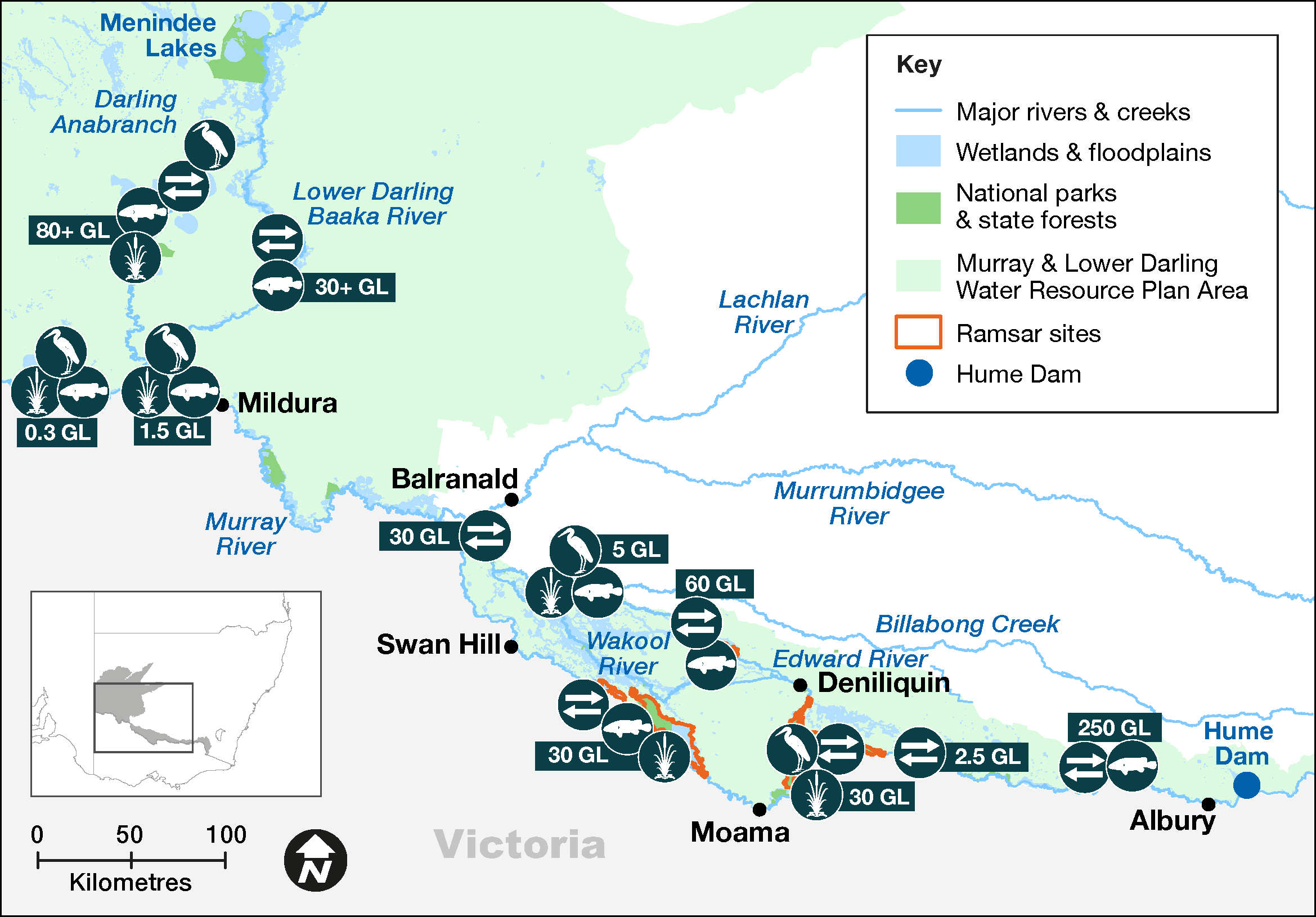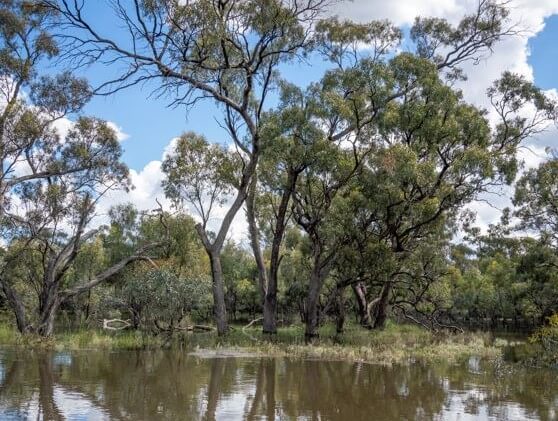Water that is allocated and managed specifically to improve the health of rivers, wetlands and floodplains is known as water for the environment.
NSW environmental water management teams work with local community advisory groups including landholders, Aboriginal stakeholders, partner agencies and other interested community members to develop detailed annual plans for the use of water for the environment in each catchment, including how its use is prioritised.
The catchment
The Murray and Lower Darling Baaka catchments cover 98,300 square kilometres and include the world’s largest stand of river red gums and Australia’s longest river, the Murray. Ramsar-listed sites include the Millewa, Werai and Koondrook–Perricoota forests, Chowilla Floodplain and River Murray Channel.
Prior to the 2018–19 fish kills, the Lower Darling Baaka River supported one of the Basin’s most robust Murray cod populations and was an important flow corridor for golden perch.
The Murray and Lower Darling Baaka catchments’ wetlands and rivers support important Aboriginal cultural values, with more than 968 cultural sites formally recorded. Aboriginal people continue to contribute important knowledge to inform the management of water for the environment.
The Murray and Lower Darling–Baaka catchments are Country to the Wiradjuri, Dhudhuroa, Waywurru, Bangerang, Barapa Barapa, Wemba Wemba, Yorta Yorta, Barkindji Maraura, Muthi Muthi, Nyeri Nyeri, Tati Tati, Wadi Wadi, Weki Weki and Ngintait Aboriginal peoples.
Water for rivers and wetlands
In 2023–24, managed environmental flows will target a range of outcomes, including:
- watering regimes that support the nationally threatened Australasian bittern and southern bell frog
- improved conditions for small-bodied native fish
- connectivity, refuge and dispersal flows for large-bodied native fish
- support for floodplain ecosystems, including the Central Murray Forest Ramsar site (Millewa, Werai and Koondrook-Perricoota).
Major flooding occurred in the Murray River, Edward-Wakool-Niemur system, Lower Darling Baaka River and Great Darling Anabranch over winter, spring and summer 2022–23. Water for the environment was used to support native fish populations during the flood and to maintain optimal nesting conditions for waterbirds at particular sites on the flood recession. Under an adaptive plan, water managers worked with other agencies and the community to coordinate the delivery of releases and to monitor, assess and manage risks.
Aboriginal water management priorities

Environmental water managers have been working to support Aboriginal people’s priorities in water management.
Water for Country is environmental water use planned by the Department of Climate Change, Energy, the Environment and Water and Aboriginal people to achieve shared benefits for the environment and cultural places, values and/ or interests.
The Murray Lower Darling Rivers Indigenous Nations are long-standing members of the Murray and Lower Darling Environmental Water Advisory Group. In 2023–2024, environmental water managers aim to deliver water into floodplains, wetlands and waterways including the Murray River and Edward–Wakool–Niemur river system, Werai Forest, Millewa Forest, Koondrook-Perricoota Forest, the Lower Darling Baaka and Darling Anabranch, and numerous other sites. Water delivery into these sites will be undertaken in partnership with Aboriginal groups and a range of delivery partners, including the Commonwealth Environmental Water Holder, Murray-Darling Basin Authority, a range of NSW and Victorian government agencies, and numerous private landowners and irrigation corporations.
Weather and water forecast
As at early June the El Niño–Southern Oscillation (ENSO1) outlook is neutral (neither La Niña nor El Niño) with oceanic and atmospheric indicators having returned to neutral ENSO levels. International climate models suggest neutral ENSO conditions are likely to persist through the southern autumn. However, there are some signs that El Niño could form later in the year.
Water managers have prepared watering plans that consider a range of weather and water availability scenarios. This is known as resource availability scenario planning. As of March 2023, ‘moderate’ conditions are forecast for the Murray and Lower Darling Baaka catchments in 2023–24.
1. ENSO: The interaction between the sea surface and atmosphere over the Pacific Ocean which results in dryer (El Nino) or wetter (La Nina) conditions.
Resource availability scenario
Current forecast: Moderate
| Conditions | Main aim | Other aims |
|---|---|---|
| Very dry | Protect | Avoid critical loss Maintain key refuges Avoid catastrophic events |
| Dry | Maintain | Maintain river functioning Maintain key functions of high priority wetlands |
| Moderate | Recover | Improve ecological health and resilience Improve opportunities for plants and animals to breed, move and thrive |
| Wet to very wet | Enhance | Restore key floodplain and wetland linkages Enhance opportunities for plants and animals to breed, move and thrive |
Key planned actions for 2023–24
Waterbirds
Water managers have planned:
- watering events for the Murray catchment national and regional parks to support sites that contain nesting Australasian bitterns and other native waterbirds. Australasian bitterns are an important story-telling species for Aboriginal people
- deliveries of up to 1 gigalitre (GL) for Lake Agnes to promote waterbird breeding for threatened species such as blue-billed ducks
- deliveries up to 3 GL for Pollack Swamp (Koondrook-Perricoota) which is a breeding site for egrets, herons and little bitterns.
Native fish
Water managers have planned Murray River multi-site flows from Hume Dam to South Australia to support native fish and instream productivity. This is a collaboration between states and agencies.
Fish flows in the Edward-Wakool system will provide benefits for native fisheries, instream vegetation and food webs.
Water managers are planning a winter–spring flow for the Lower Darling Baaka River to support native fish population recovery and recruitment. There is potential for a continuation of flow down the Great Darling Anabranch to the Murray River, water volumes permitting.
Vegetation
Water managers will deliver flows to private wetlands, providing critical habitat for southern bell frogs. Supporting the condition of remnant woodlands and other floodplain vegetation communities produces essential carbon and nutrients to support the aquatic food web and provides habitat and corridors for wildlife, such as the nationally threatened superb parrot.
Connectivity
Flows will provide connectivity between Tuppal Creek and the Edward River, Cunninyeuk, Murrain Yarrein and Cockran-Jimaringle creeks and the Niemur, Wakool rivers and Yarrein Creek.
A cultural flow is planned in the Koondrook-Perricoota Forest. This will also benefit vegetation, woodland birds and waterbirds.
Map of proposed annual priority targets in the water resource plan area 2023–24

Map of proposed annual priority targets in the water resource plan area 2023–24
The department is supporting the health and resilience of rivers and wetlands by delivering water for the environment where and when it is needed. We use the best available science, management expertise and experience to manage water across the landscape. This statement of annual priorities identifies the waterways and wetlands that are likely to receive water.
Our decision-making process considers:
- expected availability of water in the coming year
- conditions of the previous year
- current health of the plants and animals in these ecosystems.
About water for the environment
Water for the environment delivers benefits for communities, rivers, wetlands and wildlife across New South Wales.
Healthy, connected rivers and floodplains are a focus for tourism, fishing, recreation and relaxation. Rivers carry water to our homes, schools, farms and businesses, and along the way, support countless species including native fish, waterbirds, frogs, plants and more.
Rivers and wetlands have great cultural and spiritual significance for Aboriginal people.
Water for the environment is a critical tool to maintain and enhance the rivers, wetlands and wildlife we all love.
Working with communities
Local communities are at the heart of everything we do.
We involve the broader community by holding site tours and forums, and online and in-person events.
NSW water management teams consult regularly with community-based environmental water advisory groups.
Environmental water advisory groups members include local landholders, recreational fishers, Aboriginal people and local government representatives. Their advice helps to inform the decisions made by our local environmental water management teams.
Expected environmental water volumes available at 1 July 2023
The Department of Climate Change, Energy, the Environment and Water works with partner agencies to manage environmental water in the catchment.
Planned environment water
| Source | Maximum volume available (gigalitres) | Volume expected 1 July under current conditions (gigalitres) |
|---|---|---|
| Barmah–Millewa Forest environmental water allocation (BMF EWA) ^ | 700 gigalitres (up to 100 gigalitres is available annually to NSW and Victoria) | Current balance 198 gigalitres |
| Murray additional environmental water allowance (MAA) | 29 gigalitres available to NSW only | 5.7 gigalitres |
| River Murray Increased Flow | Up to 70 gigalitres available annually to NSW and Victoria in the Snowy Hydro system. Availability of RMIF in Hume is dependent on releases of RMIF from the Snowy Hydro system | 56 gigalitres currently forecast for 1 July 2022 based on SCBEWC decision on RMIF call |
Water licenced to New South Wales
| Source | Maximum volume available (gigalitres) | Volume expected 1 July under current conditions (gigalitres) |
|---|---|---|
| Murray – conveyance | 30 gigalitres | 20.8 gigalitres based on forecast 50% GS allocation |
| Murray – high security | 2.8 gigalitres | 2.7 gigalitres based on forecast 97% HS allocation |
Water licenced to the Commonwealth
| Source | Maximum volume available (gigalitres) | Volume expected 1 July under current conditions (gigalitres) |
|---|---|---|
| Murray – general security (GS) ** | 369.6 gigalitres | 180.4 gigalitres based on forecast 50% GS allocation |
| Murray – high security (HS) | 17.9 gigalitres | 17.3 gigalitres based on forecast 97% HS allocation |
| Murray – conveyance | 20.2 gigalitres | 14.0 gigalitres based on forecast 50% GS allocation |
| Lower Darling – general security (GS) | 21.6 gigalitres | 21.6 gigalitres based on forecast 100% GS allocation |
| Lower Darling – high security (HS) | 4.2 gigalitres | 4.2 gigalitres based on forecast 100% HS allocation |
NSW water licenced to The Living Murray (MDBA)
| Source | Maximum volume available (gigalitres) | Volume expected 1 July under current conditions (gigalitres) |
|---|---|---|
| Murray – general security (GS) ** | 83 gigalitres (100% entitlement) | 41.5 gigalitres based on forecast 50% allocation |
| Murray – high security (HS) | 5.1 gigalitres | 4.9 gigalitres based on forecast 97% HS allocation |
| Lower Darling – general security (GS) | 47.8 gigalitres | 47.8 gigalitres based on forecast 100% GS allocation |
| Lower Darling – high security (HS) | 0.5 gigalitres | 0.5 gigalitres based on forecast 100% HS allocation |
Note: This is an indicative summary of expected volumes to be available. For further detail and information on available volumes, please contact the region via Department of Climate Change, Energy, the Environment and Water enquiries on 1300 361 967.
^ The maximum volume of BMF EWA is 100 gigalitres per year shared equally between NSW and Victoria. The maximum accrued volume of BMF EWA is 700 gigalitres. BMF EWA is only available for environmental use when the NSW Murray general security allocation reaches 30 per cent or 50 per cent under exceptional circumstances.
** Murray general security has carryover provisions. Carryover has not been included in the Murray general security licences in the table. The carryover component will need to be considered separately, with carryover + allocations limited to 110% of the share components.
Outcomes of water for the environment
Water for the environment has been delivering outcomes for rivers, wetlands and wildlife for 30 years.
We deliver flows that:
- trigger native fish to breed and move
- support waterbirds to nest and feed
- connect rivers and floodplains
- water forests and floodplains
- allow plants to grow, flower and set seed
- create refuge during droughts
- enhance outcomes during wetter times
- release vital nutrients from the floodplain floor that underpin the aquatic food web.
It’s habitat restoration on a landscape scale.

The Murray and Lower Darling Baaka catchments cover 98,300 square kilometres.
More about...
- Long-term water plans
- Water Sharing Plan for the NSW Murray and Lower Darling Regulated Rivers Water Sources
- Murray Darling Basin Authorityopens a new window
- Murray Darling Basin Planopens a new window
- Commonwealth Environmental Water Office - Lower Murray Darlingopens a new window
- Commonwealth Environmental Water Office - Mid Murrayopens a new window
- The Living Murray Annual Environmental Watering Plan 2013-14opens a new window
More information on planned and past watering events
- Annual environmental water priorities in the Murray and Lower Darling Baaka catchments 2022–23
- Murray and Lower Darling Baaka Catchments – Water for the Environment: Annual Priorities 2021–22
- Murray and Lower Darling catchments: Annual environmental watering priorities 2020-21
- Murray and Lower Darling: Annual environmental watering priorities 2019-20
- Murray and Lower Darling catchments: Annual Environmental Watering Priorities 2018-19
- Murray and Lower Darling catchment: Annual environmental watering priorities 2017-18
- Murray and Lower Darling Water Resource Plan Area: Statement of annual environmental watering priorities 2016–17
- Murray and Lower Darling Valleys Annual Environmental Watering Plan 2014-2015
- Water for environment outcomes 2022-23
- Water for environment outcomes 2021-22
- Use of water for the environment in NSW: Outcomes 2020–21
- Use of water for the environment in NSW: Outcomes 2019–20
- Use of water for the environment in NSW: Outcomes 2018–19
- Use of water for the environment in NSW: Outcomes 2017–18